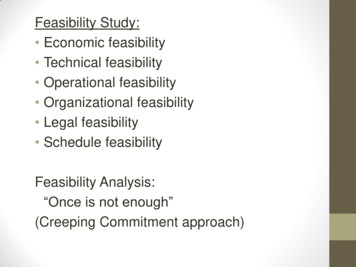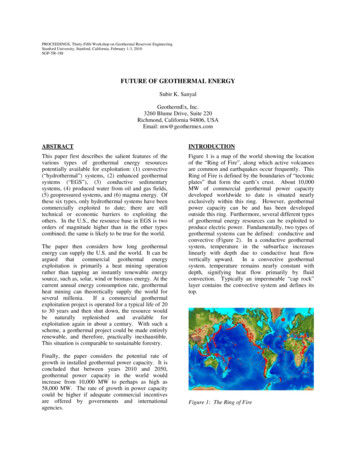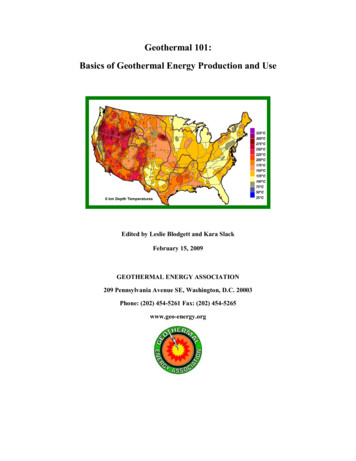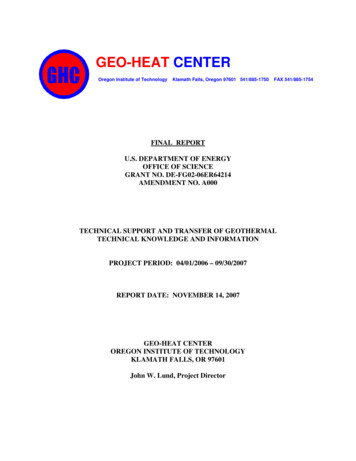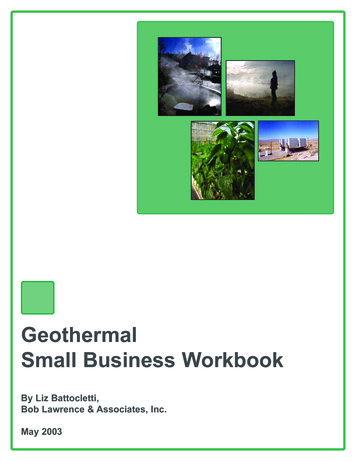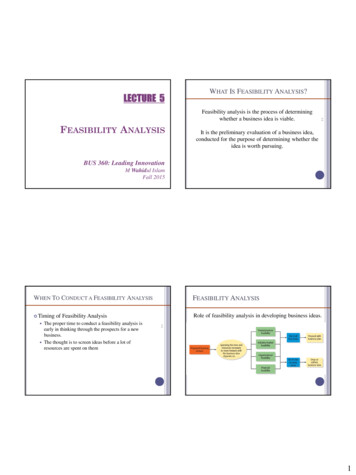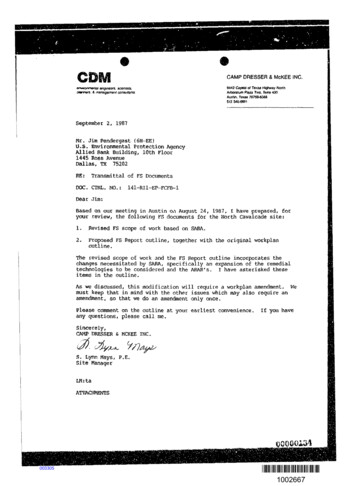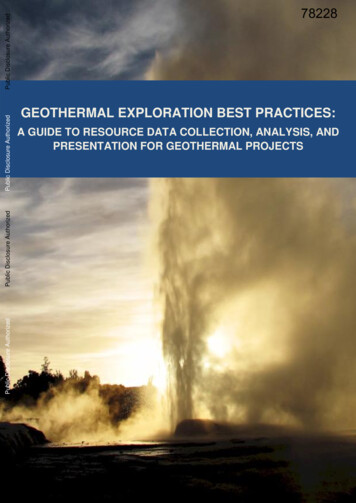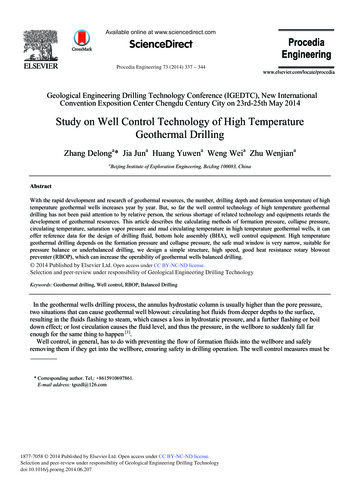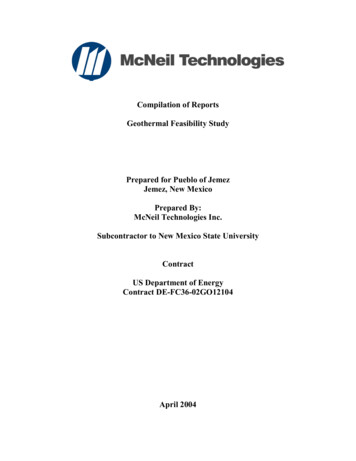
Transcription
Compilation of ReportsGeothermal Feasibility StudyPrepared for Pueblo of JemezJemez, New MexicoPrepared By:McNeil Technologies Inc.Subcontractor to New Mexico State UniversityContractUS Department of EnergyContract DE-FC36-02GO12104April 2004
Table of ContentsExecutive SummaryReports1.2.3.4.District Heating System at Red Rocks, Pueblo of Jemez, Feasibility AnalysisNative Herbs Inc. Business PlanMarket Analysis, Tree Seedling Greenhouse, Pueblo of JemezMarket Analysis, Spa, Pueblo of Jemez
Executive SummaryThe material in this document represents several reports, presentations and all of therelevant electronic files developed for the use of Pueblo of Jemez personnel. The intent ofthe overall project was to prepare a business plan for the beneficial use of the geothermalresources. To prepare the business plan we first worked with Pueblo of Jemez personnelincluding the tribal council to learn about the interests and needs of the tribe. This effortwas undertaken to determine applicable businesses that were compatible with tribalcapabilities as well as offered beneficial economic development opportunities.We held one workshop, lead by personnel from New Mexico State University, SouthwestTechnology Development Institute to provide education and material to Pueblo of Jemezpersonnel. Sandia National Laboratories personnel also collaborated on the workshop.We also had a three-day field trip to inspect geothermal sites in southern New Mexico.We visited geothermal greenhouses in Las Cruces, Radium Springs, and Cotton City. Wealso visited aquaculture facilities in Las Cruces and Cotton City. The objectives for boththe workshop and field trip were to introduce Pueblo of Jemez personnel to geothermalresources, technologies, and business opportunities.To prepare a business plan, it was necessary to assess market conditions concurrentlywith determining tribal interests and capabilities. This was an iterative process as wegathered some information, talked with various personnel at the Pueblo, and then revisedour efforts according to the feedback we received. We analyzed market opportunities forgreenhouses, aquaculture, spas and district heating. We looked at multiple niches withineach of these market segments. With feedback from the Tribal Council and the EconomicDevelopment Committee (recently re-named the Jemez Community DevelopmentCorporation), we eliminated aquaculture as a business opportunity. We then focused onspecific niches within the greenhouse market including tree seedlings and herbs for foodconsumption. We also were directed by Tribal Council to assess the spa market. Ouranalysis of the greenhouse market indicated an opportunity with herbs but a crowdedmarket space for tree seedlings. Our market analysis for spas indicated it would beeconomically difficult to develop a stand-alone spa but a spa might be a worthycomplement to other retail enterprises.Concurrent with our geothermal feasibility studies, the Pueblo of Jemez commissioned aMaster Plan for the Red Rocks area on the reservation. This is an area that is now beingassessed for development of retail enterprises that match tribal cultural needs as well asoffer solid business opportunities. We understood the potential to develop a geothermaldistrict heating infrastructure at Red Rocks to provide a sustainable, clean energy
resource for the potential development at Red Rocks. The geothermal system can providestable energy prices over a long horizon with considerable benefit to the Tribe.We then prepared two stand-alone reports. One is a business plan for a geothermallyheated greenhouse producing herbs for local and regional markets. The greenhouse wouldbe located at the southern portion of the reservation, away from the retail area. The sitehas advantages because the geothermal resource is fully confirmed and the surroundingarea is agricultural in nature. The challenge to this site is it will require somedevelopment (e.g., installation of power lines) and presently the Pueblo focus is ondeveloping the Red Rocks site, not the southern location. Further, even though thebusiness plan suggests it can be a profitable venture, personnel from Jemez will need totake ownership of the plan and move forward with it. The business opportunity willsurely change with time.The second report is a feasibility study of the district heating system at Red Rocks. Wecompared geothermal to logical alternatives, biomass and propane. Both biomass andgeothermal are assessed to be less expensive than propane. We recommend geothermalbecause of its compatibility with the location.Much work remains to be done to capture the promise of using geothermal resources onthe reservation. While the Red Rocks district heating system is a good idea and haseconomic merit, it will be necessary to complete resource assessment work. Resourceconfirmation is needed and can only be accomplished through a drilling program. This isthe necessary follow-on work.The herb greenhouse is a real business opportunity. We understand market conditionschange and within some distinct time period, perhaps less than two years, the opportunitywill be considerably different and the study will need to be re-visited. While the marketdata and business opportunity will change, we have provided a powerful electronic tool inthe form of a pro forma financial analysis. The spreadsheet model will allow for multiplewhat-if type assessments with a complete analysis of financial return. We encourage thePueblo to take advantage of the model.
District Heating System at Red RocksPueblo of Jemez, New MexicoFeasibility AnalysisPrepared for:Pueblo of JemezJemez, New Mexico 87024Funding provided by:US Department of EnergyContract DE-FC36-02GO12104Prepared by (subcontractor to New Mexico State University):McNeil Technologies, Inc.1155 University BoulevardAlbuquerque, New Mexico 87106April 2004
DISCLAIMERThis report was prepared as an account of work sponsored by an agency of the UnitedStates Government. Neither the United States Government, nor any agency thereof, norany of their employees, makes any warranty, express or implied, or assumes any legalliability or responsibility for the accuracy, completeness, or usefulness of anyinformation, apparatus, product, or process disclosed, or represents that its use would notinfringe privately owned rights. Reference herein to any specific product, process, orservice by trade name, trademark, manufacturer, or otherwise, does not necessarilyconstitute or imply its endorsement, recommendation, or favoring by the United StatesGovernment or any agency thereof. The views and opinions of authors expressed hereindo not necessarily state or reflect those of the United States Government or any agencythereof.ii
ABSTRACTA preliminary analysis of a geothermal district heating system was conducted. Thegeothermal heating system, located on the Pueblo of Jemez at Red Rocks, is designed toserve commercial retail loads for new structures that may be built in accordance withmaster planning efforts. The geothermal system was compared with two alternatives,propane and biomass. Biomass is the least costly system but geothermal is preferred dueto supply assurance and compatibility with the scenic considerations at Red Rocks. Thecost differential between biomass and geothermal is not substantial. Levelized costs forgeothermal fluids are estimated to be on the order of 14/MMBtu while biomass isapproximately 11/MMBtu, delivered. A geothermal system has the potential to receivefinancial support from either government agencies or private foundations.iii
ACKNOWLEDGMENTSThe US Department of Energy funded this study. The Pueblo of Jemez was the primecontractor. The original project manager was Mehrdad Khatibi. Mr. Steve Blodgett andMarti Blad, Ph.D. assumed management responsibility for Jemez approximately 2/3rds ofthe way through the effort. We are appreciative of their collective efforts to make thisproject succeed. Mr. Anthony Armijo was an interim project manager who worked withus to ensure we were on track with certain data and image collection activities. Hiscontributions were both timely and helpful. We also extend our thanks to Mr. TimArmijo, Director of the Pueblo of Jemez Economic Development Department. Mr.Armijo helped coordinate numerous meetings with the Tribal Council, the JemezCommunity Development Corporation, and several firms providing master planningservices to the Pueblo of Jemez.McNeil Technologies Inc. was a subcontractor to New Mexico State University,Southwest Technology Development Institute. Mr. James C. Witcher was the ProjectManager at NMSU. The authors acknowledge Jim’s contribution to the work effort andextend appreciation for his support.Finally, despite our best efforts at editing and revisions, mistakes may still remain withinthis document. Any mistakes or omissions are the sole responsibility of the authors. Anyquestions or comments should be addressed to Jack Whittier, McNeil Technologies Inc.,1155 University Boulevard, Albuquerque, NM 87106.iv
Table of ContentsExecutive Summary . i1.0Introduction. 12.0Geothermal Resource. 23.0Heating Load. 34.0Distribution Pipeline . 55.0Preliminary Engineering / Economic Analysis. 85.1Introduction. 85.2Capital Costs . 95.3Operating Costs. 105.4Spreadsheet Model Economic Inputs. 125.5Propane System. 125.6Biomass System . 125.7Geothermal System . 136.0Conclusions. 167.0Recommendations. 19List of TablesTable 1 Estimated Thermal Loads for Hypothetical Buildings at Red Rocks . 4Table 2 Estimated Cost for Geothermal Distribution and Injection Pipeline . 8Table 3 Estimated Capital Costs for Geothermal District Heating System, Red Rocks. 9Table 4 Estimated Annual Operating Costs, Geothermal District Heating System, RedRocks. 10Table 5 Estimated Electricity Demand and Energy Consumption, Geothermal DistrictHeating System, Red Rocks. 11Table 6 Estimated Labor Costs, Geothermal District Heating System, Red Rocks . 11Table 7 Estimated Benefit Rate, Geothermal District Heating System, Red Rocks. 11Table 8 Economic / Financial Assumptions for Pro Forma Model . 12Table 9 Levelized Cost of Propane, Pueblo of Jemez . 12Table 10 Estimated Capital and Operating Costs, Biomass Heating System for Red Rocks. 13Table 11 Scenario Description for Economic Evaluation of a Geothermal District HeatingSystem, Red Rocks, Pueblo of Jemez. 14Table 12 Calculated Financial Projections for Geothermal District Heating, Red Rocks,Pueblo of Jemez . 15Table 13 Comparative Advantages and Disadvantages, Propane, Biomass andGeothermal Heating Systems at Red Rocks, Pueblo of Jemez. 19Table 14 MACRS Depreciation Values. 1v
List of FiguresFigure 1 Red Rock Location Map. 2Figure 2 Estimated Development Rate for Construction of Facilities at Red Rocks. 5Figure 3 Estimated Capital Costs, Geothermal District Heating System . 10Figure 4 Projected Cash Flow, Scenario E, Geothermal District Heating System, Puebloof Jemez . 16List of AppendicesAppendix A Spa Thermal Load Calculations . 1Appendix B Projected Drilling Costs, Red Rocks . 1Appendix C Explanation of Financial Calculations. 1Appendix D Summary of New Mexico-Based Financial Resources. 3vi
Abbreviations and i2MMBFMMBtuMSWMWMWhNPVNNOxNRELODBone-dry, or containing 0% moisture content; also referred to as oven-dryU.S. Bureau of Land ManagementBritish thermal unitsCelsiushundred cubic feet (ft3)cubic feet (ft3)circulating fluidized bedCode of Federal Regulationscombined heat and powerCarbon monoxideCarbon dioxidediameter breast heightDepartment of Environmental QualityU.S. Department of EnergyU.S. Department of InteriorU.S. DOE Energy Information AdministrationU.S. Environmental Protection AgencyEnergy Policy ActFahrenheitFederal Insurance Contributions Act (Social Security)Federal Unemployment Tax ActHydrogenhigher heating valueHorsepowerGallons per Minutekilowattkilowatt-hourpoundslower heating valueModified Accelerated Cost Recovery Systemmoisture contentMillion cubic feetSquare milesmillion board feetmillion British thermal unitsMunicipal Solid Wastemegawattmegawatt-hourNet Present ValueNitrogenOxides of nitrogenNational Renewable Energy LaboratoryOven-dry, or containing 0% moisture content; also referred to as bone-dryvii
ODTpsiPURPAREPAROIRTRPSOxSSUITSIUSFSVOCwt %WTyroven dry tonspounds per square inchPublic Utility Regulatory Policy ActRenewable Energy Production IncentiveReturn on InvestmentReinforced thermosetting resin pipeOxides of sulfurSulfurState unemployment insuranceTimber Stand ImprovementUnited State Forest Servicevolatile organic compoundweight percentWet tonsyearviii
Executive SummaryA geothermal district heating system has the potential to offer substantial benefits. Theprimary benefit is a stable energy price for a long period of time. Other benefits includethe potential for a competitive price, use of a renewable, non-polluting, resource plusquiet operation. Further, the Pueblo of Jemez could achieve a measure of energy selfsufficiency and retain valuable dollars within the community.The benefits of the district heating system can be realized if there is proper considerationgiven to the infrastructure development. It is anticipated that the build-out to realize theMaster Plan will take a period of years to accomplish. At the time of this report, Spring2004, it is uncertain as to the precise nature of the Master Plan although there is a generalunderstanding that the planning effort is directed towards establishing the Red Rocks areaas a commercial center to attract and retain retail trade. The intent is to respect thephysical aesthetics of Red Rocks while providing limited development to complementPueblo of Jemez economic goals.It is understood that for the district heating system to be successful, early incorporation ofthe pipeline and associated heating systems will be necessary. Simply put, retrofit ofbuildings to accommodate a new heating system is expensive and often not costeffective. To realize the long-term advantages of the geothermal district heating system itwill be necessary to install the infrastructure well in advance of the build-out of the site.While this means the district heating system will be underutilized in the early years ofoperation as new loads are being added, it allows for a gradual incorporation of thetechnology into the planning efforts.From a delivered cost of energy perspective, geothermal represents the second lowestcost for the range of fuels available at Red Rocks. Biomass is less expensive thangeothermal but it can reasonably be argued that geothermal has a slight competitiveadvantage because of the assurance of supply. Biomass supply is ample and will be formany years. However, given the litigious nature of harvesting material from NationalForests, it is difficult to have confidence the biomass supply will be reliable year afteryear. By contrast, the geothermal resource is directly under the Red Rocks location and isaccessible on a continuous basis.Table ES-1 provides a qualitative comparison between the three energy supply sourcesthat have been addressed in this report. The intent of Table 13 is to provide comparativeinformation to illustrate the differences between the various technologies to fosterdecision-making. The comparative approach provides several categories of interestrelevant to project development including capital and operating considerations,environmental attributes, and inclusion of issues germane to the Pueblo of Jemez.Capital requirements illustrate a dramatic difference. A propane system has a low initialcost as well as overall low replacement costs. Indeed the capital costs are approximately10% of the geothermal costs. However, there is little chance to obtain financial supportfor the system from government or foundation sources. Conversely, both of therenewable technologies have relatively moderate or high initial costs but are goodcandidates for obtaining financial assistance, largely because of public support for greateradoption of sustainable practices.i
From a cash flow perspective, a propane system offers the smallest year-to-year impacton scarce investment funds but not annual operating costs. This is both because of thelow initial cost as well as it is not necessary to incur large annual finance costs for debtrepayment. Both the biomass system and the geothermal system require moderate or highinitial costs that are assumed to be financed over the project lifetime. Annual cashrequirements for debt repayment are relatively high compared to a propane system.Operating costs illustrate one of the conundrums of renewable energy utilization,particularly for the geothermal system. While the initial costs for renewable technologiesare high, the annual operating costs are considerably less than for a propane system.Further, the required management and labor skills, particularly for the geothermal system,are low indicating the ease of operating the system. Finally, the geothermal system offersthe prospect of stable, predictable fuel prices. Neither the propane or biomass systemscan offer similar assurance of price or supply stability. In addition, biomass supply willrequire several truckloads per week to be delivered to the site.Levelized annual costs incorporate both capital and operating costs discounted over theproject horizon thereby allowing for a comparison among the different technologies on anormalized basis. From the levelized cost perspective, both biomass and geothermaltechnologies are roughly half as expensive as propane over twenty years. This strikingdifference illustrates the effect low operating costs have relative to high investment costs(particularly for the geothermal system).Pueblo of Jemez personnel have expressed considerable concern for the environmentalimpacts associated with development on the reservation, particularly at the scenic RedRocks location. Both biomass and geothermal offer attractive environmental or greenattributes with both considered sustainable resources over a long period of time. Propane,a fossil fuel, has low air emissions except for CO2, relative to either biomass orgeothermal. Biomass combustion systems do have air emissions of CO2, CO, NOx, smalllevels of SOx in addition to a small but discernible visible plume from the emission stack.Biomass systems have received air permits in areas with stringent air emissionrequirements and meet all US Environmental Protection Agency emission levels. Further,societal benefits associated with biomass fuel supply from small diameter material in thesurrounding tribal trust lands, Valles Caldera National Preserve and the Santa Fe NationalForest are considerable. Amelioration of forest fire threat through the reduction of highstand density coupled with removal of dead or dying trees that are infected by the pinebark beetle has high public value that is difficult to quantify.A geothermal system will emit no or negligible air emissions. The spent geothermalfluids will be injected back into the aquifer. Care must be exercised in siting the disposalwell to assure that valuable potable water supplies are not contaminated. The footprint ofthe geothermal system is limited to the wellhead and pipeline. The pipeline will requiretrenching and therefore soil disturbance.It is also important to consider impacts the proposed energy infrastructure would have onother Pueblo of Jemez activities. For example, both the propane and biomass systemswould complement on-going enterprises. There is a small propane supplier business onthe reservation and the Walatowa Woodlands Initiative (WWI) presently employsii
approximately 10 individuals for thinning and processing small diameter wood products.Either organization could effectively supply fuel to the heating system.In general, both the biomass and geothermal systems will retain fuel dollars in the localcommunity. Biomass fuel costs will pay for salaries for WWI personnel while the royaltypayments associated with the geothermal system will return funds to the tribe to offsetutilization of the natural resources.Table ES-1 Comparative Advantages and Disadvantages, Propane, Biomass andGeothermal Heating Systems at Red Rocks, Pueblo of JemezCategoryPropane Biomass GeothermalCapital RequirementsInitial capital investmentLowModerateHighPeriodic replacement costsLowLowModeratePotential for cost-share capitalLowHighHighOperating ConsiderationsHigh ModerateLowAnnual costsHigh Moderate ModerateLevelized costsLowModerateLowManagement experienceLowLowLowLabor skillsVolatile VariableStableFuel price stabilityModerate HighLowSupply assurance riskGreen StatusNoYesYesSustainableLowLowNoneAir emissionsModerateLowNoneGreenhouse gas emissionsNoHighModerateSocial benefitsPueblo ConsiderationsYesYesNoComplements existing tribal enterprisesNoYesYesFuel dollars remain in communityRecommendations for future actions include the following: Given the uncertainty regarding the true nature of the geothermal resource at RedRocks, a complete drilling exploration / confirmation plan needs to be executed.We recognize the Pueblo of Jemez is pursuing this activity via a recent proposalto BIA.The Master Plan should give careful consideration to a district heating system,either biomass or geothermal. The infrastructure for such a system should bedesigned from the start to accommodate future expansion.All buildings that are being considered for the Red Rocks commercial districtneed to incorporate careful consideration of the energy system. This considerationincludes both energy efficiency measures, including solar orientation, as well asaccommodation of either geothermal or biomass energy systems. It is stronglyrecommended that the buildings utilize a hot water circulation loop for spaceheating.Infrastructure development support funds from public organizations should besought as early as possible. The US Departments of Commerce, Agriculture,iii
Energy and Interior all have programs that address either renewable energyutilization or infrastructure development. The Pueblo of Jemez should begin to consider establishment of a tribal utilityauthority (TUA) to run the district heating system. The authority would beresponsible for management of the system, possibly through the Public WorksDepartment. The overall concept behind a tribal utility authority is tribal selfdetermination or the extent to which Pueblo of Jemez desires to control variousaspects of its destiny. The geothermal district heating system can be utilized toestablish the framework for such functions as:1. Billing2. Operations management3. Records keeping and periodic filing with applicable agencies Over time the district heating TUA could be expanded to include provision oftelecommunications and electricity services.iv
IntroductionThe Pueblo of Jemez has commissioned an initial master planning effort for the RedRocks area (see location map Figure 1). Fortuitously, the planning work is beingconducted concurrently with the geothermal resource assessment and economicfeasibility effort funded by the US Department of Energy (DOE). Because of the knowngeothermal resource potential at Red Rocks, it is prudent to assess the initial feasibility ofinstalling a district heating system to meet the thermal demands for the various buildingsthat might be constructed.A geothermal district heating system has the potential to offer substantial benefits. Theprimary benefit is a stable energy price for a long period of time. Other benefits includethe potential for a competitive price, use of a renewable, non-polluting resource plusquiet operation. Further, the Pueblo of Jemez could achieve a measure of energy selfsufficiency and retain valuable dollars within the community.The benefits of the district heating system can be realized if there is proper considerationgiven to the infrastructure development. It is anticipated that the build-out to realize theMaster Plan will take a period of years to accomplish. At the time of this report, Spring2004, it is uncertain as to the precise nature of the Master Plan although there is a generalunderstanding that the planning effort is directed towards establishing the Red Rocks areaas a commercial center to attract and retain retail trade. The intent is to respect thephysical aesthetics of Red Rocks while providing limited development to complementPueblo of Jemez economic goals.It is understood that for the district heating system to be successful, early incorporation ofthe pipeline and associated heating systems will be necessary. Simply put, retrofit ofbuildings to accommodate a new heating system is expensive and often not costeffective. To realize the long-term advantages of the geothermal district heating system itwill be necessary to install the infrastructure well in advance of the build-out of the site.While this means the district heating system will be underutilized in the early years ofoperation as new loads are being added, it allows for a gradual incorporation of thetechnology into the planning efforts.Figure 1 provides an aerial picture of Red Rocks overlain with a location map. Theexisting infrastructure for the buildings and roads is shown. Hypothetical wells sites areindicated as well as a possible pipeline route. It is important to note the wells and pipelineare purposely sited to minimize aesthetic concerns and avoid culturally sensitive areas.Not shown on the map but included in the following analysis is another potential pipelinethat would travel east and serve a potential retail spa.1
Figure 1 Red Rock Location MapGeothermal Resource1No thermal springs or thermal wells exist in the Red Rocks area along Highway 4 northof the main Jemez Pueblo village. However, the area overlies possible subsurface flowpaths for the outflow plume from the Valles geothermal system to the north (Goff andothers, 1988). Heat flow and temperature gradient information indicates potential for alateral outflow plume geothermal reservoir beneath the area. There are several likelyreservoir targets but drilling needs to be accomplished to have certainty there is a viableresource at the site.We have had numerous discussions regarding the likelihood of “finding” geothermalresources at the Red Rocks location. At this time, Spring 2004, it is considered highlylikely that a substantial reservoir exists at the site and that successful drilling could beaccomplished in the immediate vicinity of the Red Rocks area. The Pueblo of Jemez hasapplied for funds from the Bureau of Indian Affairs to conduct preliminary drilling at thesite to help confirm the presence of geothermal fluids.For the purposes of this report, it is assumed there is a reservoir that is capable ofproducing 150 F fluids with flow rates in excess of 500 gallons per minute (gpm). The1The material in this section is derived from Witcher, James C., Geothermal Reservoirs and GeothermalDrilling at Jemez Pueblo, March 31, 2004 (draft).2
estimated depth to the reservoir is 1,000 feet and the reservoir is assumed to have alifetime in excess of fifty years. Water quality is assumed to be comparable to thegeothermal fluids from the well located on the southern portion of the reservation.2Heating LoadDevelopment at Red Rocks is presently limite
The second report is a feasibility study of the district heating system at Red Rocks. We compared geothermal to logical alternatives, biomass and propane. Both biomass and geothermal are assessed to be less expensive than propane. We recommend geothermal because of its compatibility with the location.
